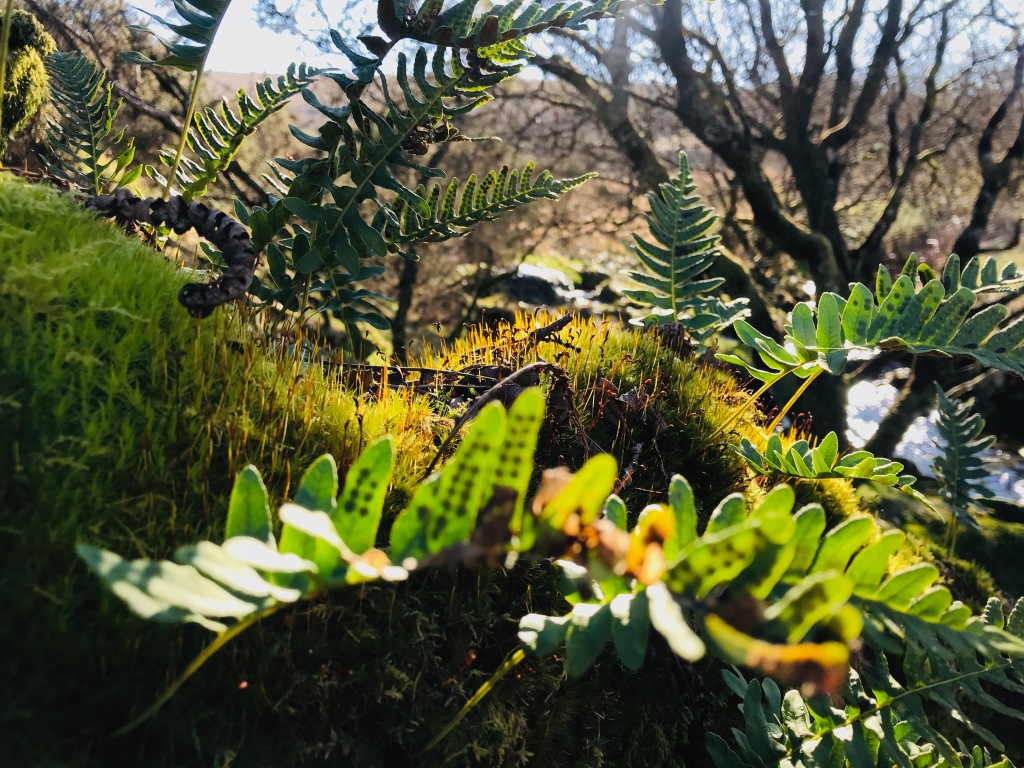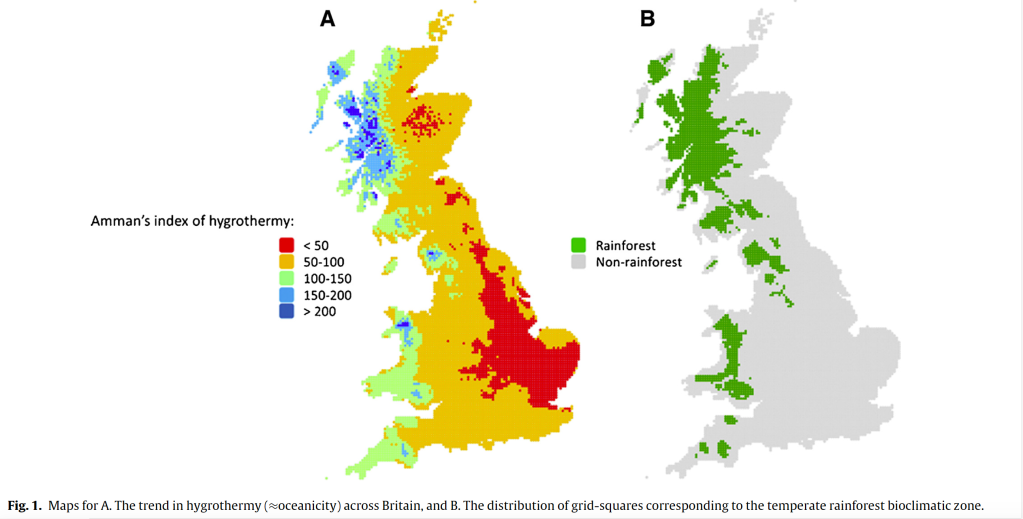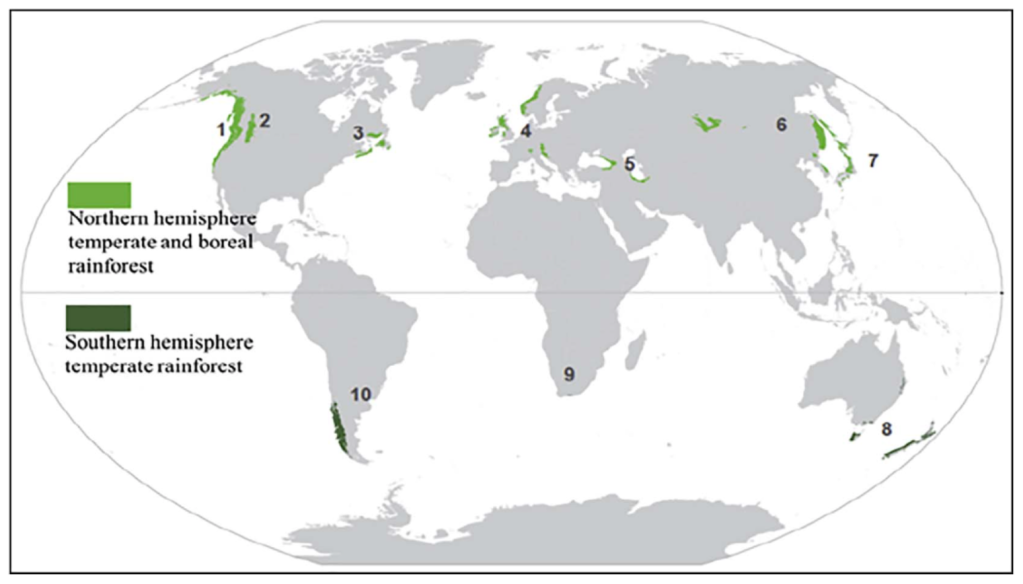Few people realise that Britain harbours fragments of a globally rare habitat: temperate rainforest.
Everyone’s heard of tropical rainforests. But we also have rainforests in Europe! Temperate rainforests occur in mid-latitude, temperate zones, in places which receive heavy rainfall due to an ‘oceanic’ climate.
Put more simply: temperate rainforests are very damp woodlands – so damp that plants grow on other plants. These plants are known as ‘epiphytes’. If you want to recognise temperate rainforest in Britain, the key indicator is an abundance of mosses, lichens and polypody ferns festooning the branches and trunks of trees.

The hallmarks of British temperate rainforest: polypody ferns, mosses and lichens carpet branches on trees growing along the O Brook, Dartmoor.
The temperate rainforest bioclimatic zone in Britain has been mapped by Christopher Ellis (2016) (see below). Large swathes of England, Scotland and Wales possess conditions for temperate rainforest. Although only tiny fragments remain today, the west coast of Britain would have supported far more rainforests in the period between the last Ice Age and the Bronze Age; some of our rainforests were cut down as recently as the 20th century.
Major temperate rainforest zones in Britain are on the west coast of Scotland; Snowdonia and the Elenydd in Wales; and in England, the Lake District, Forest of Bowland, Yorkshire Dales, Pennines, and Westcountry. Our lost rainforests may also extend beyond the main zones shown in Ellis’ map, into damp ravines and steep-sided gorges across the western seaboard of the country, where the moist microclimates can support epiphytes. One of the first things I’m trying to do is crowdsource a more detailed map of remaining fragments of temperate rainforest across Britain.

In some ways, British ‘temperate rainforest’ is a recent re-discovery – or re-branding – of a habitat previously known by other names. It used to be called ‘Atlantic oakwood’, being predominantly (but not solely) oak woodlands found along the Atlantic seaboard. In earlier decades, it was often simply referred to as ‘scrub oak’. This was partly descriptive – many upland oak woods have shrunken, shrublike forms – but also pejorative. Unlike the sturdy lowland oak, whose mighty trunks provided timber for England’s navy, many saw the twisted and stunted oaks of Britain’s temperate rainforests as useless, good only for fuel or charcoal. This led to the destruction of many of our rainforests.
Where are temperate rainforests found around the world?
The map below is taken from Mackey et al. (2017), who adapted it from D.A. DellaSala, Temperate and Boreal Rainforests of the World: Ecology and Conservation (2011). As you can see, it’s a globally rare habitat, and the UK’s temperate rainforest is of international importance. So let’s bring back Britain’s lost rainforests.


Really enjoyed learning about this. Thank you.
LikeLike
It’s heartening to read of these special places getting attention. Undoubtedly some of the UK finest habit and so shockingly scarce. Thank you for raising awareness. A very worthwhile project.
LikeLike
Worth looking at what is happening in Scotland. https://savingscotlandsrainforest.org.uk/
LikeLike
Great that these wonderful patches of woodland are being recognised as really special. What’s really important is to maximise the opportunities for natural regeneration. On Dartmoor where I live all the famous upland oakwoods could be allowed to grow significantly larger if grazing were to be restricted around them, so they could spread further along the valley floors and slopes.
LikeLike
This is fascinating.
I’ve moved from England to Galicia in northern Spain. Here, despite numerous Eucalyptus and pine plantations, there are still large areas of small scrub oak festooned with lichen and moss and ferns. It’s humid, damp and green. Is this also temporal rain forest?
LikeLike
Very good point. The climate and elevation, although at the southern limit in Galicia, is conducive to the development of temperature rainforest, aka western or Atlantic oakwood, and here in the UK referred to as well as ‘upland oakwoods’ priority habitat. As a forester in the UK, I agree, there are Atlantic oak forests in Galicia, that should come under the wider umbrella of temperate rain forest, and be recognised as such. Shockingly, deforestation is a pressure in Galicia, despite being a part of the EU!
LikeLike
Really informative and intriguing blog – thank you. I have been fortunate to visit temperate rainforests on the West Coast of Canada, which are extensive, and also have to advantage of the presence of large predators.
I wonder of these are represented in any way in the Natural England’s list of “Priority Habitats”? If not how does this affect incentives for landowners to restore these as target systems?
LikeLike
What is the ‘cut off’ before you have to say that a bit of moss growing on some trees is not really remnant rainforest?
I live on Cotswold Edge near Gloucester. There are certainly small pockets in the steepest west-facing nooks and crannies overlooking Vale of Berkeley where there is a significant amount of moss growing up trunks, occasionally quite high, and more thickly all over the fallen trees, stumps and smaller plants (but not ferns, except maybe once or twice I’ve seen it). Does this count? Its not the uber-luxuriant covering seen on some photos on this site. I can take/send photos if interested.
LikeLike
Fascinating ! I hadn’t realized that England has it’s share of TRF , I thought it was the preserve of Scotland and wales. I am amazed to see that Boggert Hole Clough is listed , a municipal park in Manchester. The more so because I grew up in the fifties across the road from there ! and where my brother still lives. I think we will probably do some latter day re-exploring !
LikeLike
Thank you very much for this! Greetings from the Chilean province of the Temperate Rainforest domains. We need to make worldwide alliances to save and restore these precious forest type.
Have you seen the following? It seems that there are more people wirking on this there in the UK:
http://www.self-willed-land.org.uk/articles/rain_forest.htm
LikeLike
WOW! I found your site through your Guardian article. Looking at the pictures of the temperate rainforests in the UK I saw resemblances to the forests in my area–Nova Scotia, Canada. The map above confirmed that where I live is a region with temperate rainforest. All the more reason to make sure our Nova Scotian forests are protected.
LikeLike
I believe I live in one of Devon’s temperate rainforests. Assorted bryophytes and polypodium thrive in my garden!
LikeLike
The same here in the Blackdown Hills in Stapley near Taunton
LikeLike
Any clear idea on the spccies composition of ancient rainforest in the UK? This could be determined by examination of pollen in sediment cores in lakes . These can also be dated with C-14. Perhaps there have been studies of this?
On the west coast of N America our forests are dominated by conifer species which tend to be long lived, And perhaps more important is that conifer dead material, both standing and on the ground, can persist for a very long time . A key way our old growth forest is identified is the quantity of dead material, ,something which was not understood until the late 1970s. The wood chemistry of the conifer trees is different from the broadleafed trees which do not last long as woody debris. 25 years after a wind storm blows down broadleafed trees, little of them will be left,
Except for the wettest coastal places, our conifer forests have a dry period of 4-5 months , resulting in hot fires over the centuries. These of course left a lot of dead material behind although the snags could stand for decades, providing habitat for various creatures.
I have never been to the UK but I flew over Wales and Ireland one fine day and was surprised to see so few trees in a region with such high rainfall, A revelation to me,
I
LikeLike
Very interesting programme about Temperate Rainforests in the UK on the Open Country strand on BBC Radio 4 this morning. Available to catch up on the BBC Sounds app.
Has triggered my interest and I will be out photographing and submitting what I find.
LikeLike
There are alot of parcels of woodland in the Forest of Dean that I believe fall into this category
LikeLike
I used to go to exmoor a lot a s a kid, especially West lucombe. There a re a lot of tiny steep sided valleys with tumbling streams and if my memory serves correctly many of the trees had a lot of moss and ferns growing on them.
There are also a number of ancient woodlands in North Somerset where I grew up such as Bourton Combe. Not sure if they count as temperate rainforest or not, but I would say they were worth checking out.
Another I can think of which could qualify are parts of the woodland on the Waterfall walk in Ingleton in the Yorkshire Dales.
LikeLike
I just heard about it today,
whisked me way
to Wistman’s Wood,
and there she stood,
a lone recruit
had escaped pursuit
of yon bovines o’re the hill.
I suspect that the mere exclusion of their ruminations might bring the forest back. It appears that the stones and the trees’ distortions may have discouraged ancient woodsmen and that the cow preference for smooth terrain save the lone escapee.
It would be nice to know the extent of natural recruitment, something about the nutrient cycle, soil/geological profile, and soil microbiome function.
LikeLike
I LOVE the wilds of Lochaber.
LikeLike
https://www.geograph.org.uk/snippet/23760
There is a link to Lost Forests of Britain on Geograph.
LikeLike